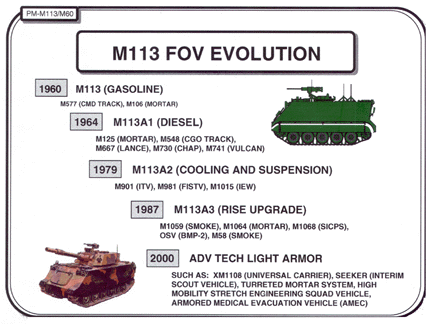

![]()
M113 Armored Personnel Carrier
The original M113 Armored Personnel Carrier (APC) helped to revolutionize mobile military operations. The vehicles were able to carry 11 soldiers plus a driver and track commander under armor protection across hostile battlefield environments. More importantly, the new vehicles were air transportable, air-droppable, and swimmable, allowing planners to incorporate APCs in a much wider range of combat situations, including many "rapid deployment" scenarios. The M113s were so successful that they were quickly identified as the foundation for a family of vehicles. Early derivatives included both command post (M577) and mortar carrier (M106) configurations.
Originally, the M113 APC was intended merely as a troop carrier-a means of transport. Doctrine stated that the infantry were to dismount and engage the enemy. It soon became apparent that the firepower of the .50-caliber machine gun, coupled with the vehicle's armor protection and mobility, produced a shock effect on the enemy. Some advisers and commanders realized that since the Viet Cong had no effective weapons to fight armor the M113 could be used as a mounted armored fighting vehicle.
Perhaps the best way to judge the success of the M113 is to examine the enemy reaction to it. The Viet Cong were not prepared for M113's when the South Vietnamese first used them in mid-1962. The Viet Cong doctrine stressed occupation of dug-in positions in the face of APC assaults, and enemy soldiers were soon learning crude methods of destroying the M113. Holes the size of an APC, nicknamed tiger traps by advisers, were soon found in delta roads. Observing the difficulties that APC units had in crossing canals, the Viet Cong used canals as obstacles in their positions, and frequently they mined possible crossing sites.
In 1965 the Viet Cong published a comprehensive and fairly accurate training document entitled Attack on M113 APC. This document listed characteristics of the APC; organization, equipment, and strength of mechanized units; tactics used by APC units; methods of attacking an APC; and some training techniques. Included were instructions for using the new antitank weapons. In the spring of 1963 the Viet Cong had begun to use recoilless rifles with 57-mm. high explosive, antitank rounds, and the number of hits on M113's had increased dramatically by the fall of 1963. Although the rounds often penetrated, they did not usually destroy the M113. Late in that year, armor-piercing .30-caliber ammunition along with a large number of automatic weapons was found in a Viet Cong cache in the delta. The extent of the Viet Cong antiarmor equipment became apparent when, in August 1963, an armor-piercing grenade was discovered. The first 75-mm. recoilless rifle was captured in September, and in December the first M113 was damaged by a 75-mm. round. This arms buildup continued into 1964, when a variety of mines, both pressure and electrically detonated, accounted for the majority of damaged and destroyed vehicles.
By 1965 the Viet Cong was using armor-defeating weapons as low as company level among regular and provincial units. Newly organized weapons platoons, companies, and battalions armed with 57-mm. and 75-mm. recoilless rifles and .50-caliber machine guns were issued the rocket propelled antitank grenade, RPG2. For several years this weapon with its B40 warhead was the principal enemy weapon against armor. Eventually, the RPG2 was replaced by the RPG7, an improved antitank grenade with a more lethal warhead, greater range, and a better sight.
![]()









| General | |
| Length | 191.5" |
| Width | 105.75" |
| Height | 86.5" |
| Clearance | 16" |
| Weight, combat loaded | 27,180 lb. (12,329 kg) |
| Maximum weight | 31,000 lb. (14,061 kg) |
| Net weight | 23,880 lb. (10,832 kg) |
| Air drop weight | 22,128 lb. (10,037 kg) |
| Personnel capacity | 2 + 11 |
| Fuel tank capacity | 95 gallons (360 liters) |
| Ground pressure | 8.63 psi (0.60 kg/cm2) |
| Performance | |
| Speed on land | 41 mi/h (66 km/h) |
| Speed in water, with track | 3.6 mi/h (5.8 km/h) |
| Cruising range | 300 mi (483 km) |
| Turning radius | Pivot to infinite |
| Slope | 60% |
| Side slope | 40% |
| Trench crossing | 66 in. (168 cm) |
| Vertical wall climbing | 24 in. (61 cm) |
| Braking (20-0 mi/h) | 40 ft. |
| Engine | |
| Make and model | Detroit Diesel 6V53T |
| Displacement | 318 in.3 (5.2 liter) |
| Fuel | Diesel (DF2) |
| Rated horsepower | 275 hp |
| Gross horsepower-to-weight ratio | 20.2 hp/ton |
| Transmission, Automatic | |
| Make and model | Allison X200-4B |
| Type | Hydrokinetic |
| Steering | Hydrostatic |
| Brake type | Multiple wet plate |
| Running Gear | |
| Suspension | Torsion bar |
| Road wheels | 5 per side, 24 inch diameter (61 cm) |
| Track type | Steel single pin, detachable rubber pad |
| Number of shoes | 63 left, 64 right |
| Track pitch | 6 in. (15.2 cm) |
| Track width | 15 in. (38 cm) |
| Shock absorbers | 3 per side |
| Wheel travel | 9.0 in. (22.9 cm) |
| Electrical System | |
| Generator |
|
| Amperes | 200, 300 optional |
| Volts, dc | 28 |
| Batteries | 4, type 6TL, 120 amp-hr, 12-volt each |
| Armament | |
| 50 cal MG | 2,000 ready rds. |
| Armor | |
| Basic hull | 5083 Aluminum |
| Bolt-on armor kit | Steel armor |
| Mine armor | Steel armor |
| Gun shield kit | Steel armor |
| Spall suppressant | Composite panel |
| Fire Extinguishers | |
| Fixed | 5 lb. (2.3 kg) CO2 for engine compartment |
| Portable | 5 lb. (2.3 kg) CO2 |
![]()

![]()
![]()





















/idata%2F0396584%2FKOREA%2F71910_korea_MIA1_800.JPG)
/idata%2F0396584%2FU.S.ARMY-POST-WW2%2Fphot4901a.jpg)
/idata%2F0396584%2FDRAWINGS-UNIFORMS-WW2%2F30-451-09b-2.jpg)
/idata%2F0396584%2FP-40%2F44FS000.jpg)
/idata%2F0396584%2FGERMAN-U-BOAT%2FBundesarchiv_Bild_101II-MW-1031-28-_Lorient-_U-31.jpg)
/idata%2F0396584%2FSOVIET-ARMY-WW2%2F1.jpg)




